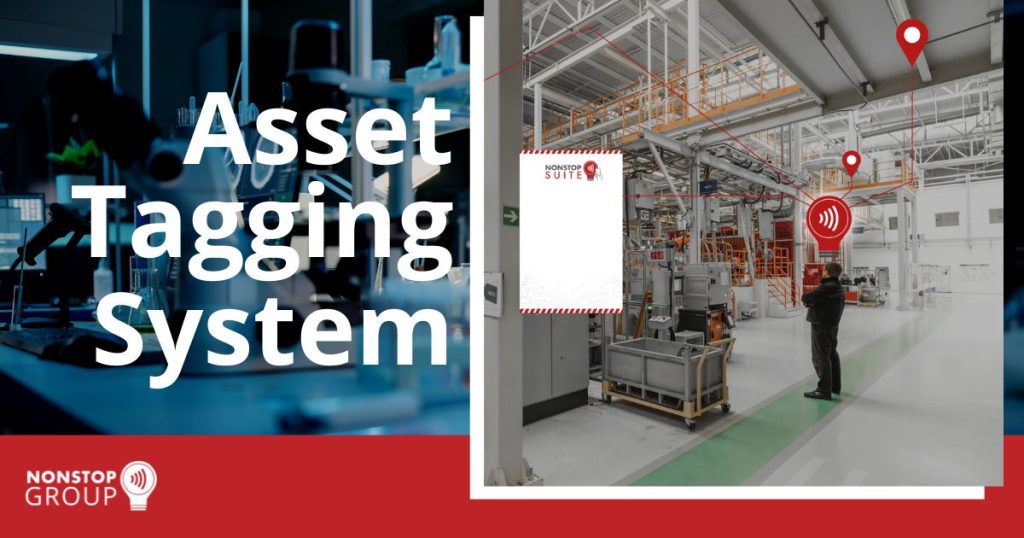6 Min Read

In the world of modern businesses, managing assets efficiently and safeguarding them against losses is a challenge faced by organizations of all sizes. The need for a robust and reliable asset management system has become more pressing than ever.
That’s where the game-changing asset tagging system comes into play, revolutionizing how organizations track, monitor, and protect their valuable resources. It’s like giving our assets a high-tech GPS! With this nifty solution, organizations can stay on top of their valuable resources like never before. In fact, research has shown that asset tagging systems can boost asset tracking accuracy by a jaw-dropping 99%!
In this super comprehensive blog post, we’ll dive into the concept of an asset tagging system, exploring how it applies to different industries, and uncovering the countless benefits it brings to enterprise businesses. So, buckle up and let’s explore the amazing world of asset management!
What is an Asset Tagging System?
With numerous assets to keep track of, it becomes imperative to implement an efficient and reliable asset tagging system. An asset tagging system provides a comprehensive solution designed to simplify asset management by assigning unique identifiers to individual assets within an organization. These identifiers, often in barcodes or Radio Frequency Identification (RFID) tags, contain vital information about the asset, such as its location, maintenance history, and other relevant details.
Based on Computerized Maintenance Management Systems (CMMS), an asset tagging system plays a crucial role in the smooth operation of any organization with fixed and moveable assets. With such an advanced and strategic system, asset-intensive organizations can streamline inventory management, asset tracking processes and gain better control over their resources.
Example of Asset Tracking System
An example of asset tagging can be seen in a large hospital where numerous medical equipment and devices are used daily. Each piece of equipment, whether an X-ray machine, an infusion pump, or a surgical instrument, is assigned a unique asset tag.
This tag contains essential information like the equipment’s serial number, date of purchase, and maintenance schedule. With this system in place, hospital staff can easily locate and track equipment, ensuring it is readily available when needed and reducing the risk of loss or misplacement.
What are The Key Components of Asset Tagging Systems?
An asset tagging system typically consists of the following 8 key components that work together to enable efficient tracking and management of assets:
1. Asset Tags:
Asset tags are physical labels, or identifiers affixed to assets. These tags typically include a unique identification number or barcode, allowing easy identification and scanning. Asset tags can be made of various materials, such as durable labels, metal plates, or RFID tags, depending on the specific requirements of the asset tracking system.
2. Identification and Tracking Technology:
Asset tagging systems employ various identification and tracking technologies to capture asset data. Common technologies include barcodes, QR codes, RFID (Radio Frequency Identification), and GPS (Global Positioning System). These technologies enable automated data capture and streamline the asset-tracking process.
3. Asset Tracking Software:
Asset tracking and tagging software is a crucial component that facilitates the management and monitoring of assets throughout their lifecycle. The software provides a centralized database or system where asset information is stored, including details like asset description, location, status, maintenance history, and user assignments. Asset tracking software often includes features like real-time tracking, reporting, alert notifications, and integration with other systems (e.g., inventory management or maintenance systems).
4. Asset Tag Scanners:
Scanning devices are used to read the asset tags and capture asset data. These devices range from handheld barcode scanners to RFID readers or mobile devices with built-in scanners. Scanning devices communicate with the asset tracking software. This capability allows for data synchronization and updating of asset information in real time.
5. Data Connectivity:
Asset tagging systems require a means of data connectivity to transmit asset information between the scanning devices and the asset tracking software. Depending on the system’s design and infrastructure, this can be achieved through wired connections, wireless networks (such as Wi-Fi or Bluetooth), or cloud-based solutions.
6. Data Storage and Management:
The asset tagging system needs a secure and reliable storage mechanism for storing asset data. It can involve on-premises servers, cloud-based servers, or a combination of both. The data storage should ensure data integrity, backup capabilities, and appropriate access controls to protect sensitive asset information.
7. Reporting and Analytics:
A robust asset tagging process often includes reporting and analytics capabilities. This allows users to generate custom reports on asset utilization, maintenance history, depreciation, and other relevant metrics. Analytical tools can provide insights to optimize asset management processes, identify trends, and make informed asset allocation and maintenance decisions.
8. Policies and Procedures:
Implementing an asset tagging system requires well-defined policies and procedures. Adhering to the standard guidelines, the asset tagging software governs the use, deployment, and maintenance of asset tags, as well as the overall asset management process. These guidelines ensure consistency, accuracy, and adherence to best practices throughout the organization.
PRO TIP
The NonStop Suite’s NFC Asset tagging system is a complete package, meticulously designed with all these key components and more!
Integrate this smart asset-tracking solution into your strategy and effectively track, manage, and optimize your assets, ultimately improving operational efficiency, cutting costs, and enhancing decision-making.
Smarter Asset Tracking With NFC Tags
Learn more about how NonStop Suite's NFC Asset Tracking Solution can help your Enterprise streamline operations to new heights.
Get A Free Product Tour
Asset Tagging System Can Be Implemented in Different Industries

Asset tagging systems find practical applications in a wide range of industries, helping organizations improve their operational efficiency, streamline workflows, and optimize resource management.
Detailed below is how asset tagging benefits 3 major industrial sectors:
Healthcare and Medical Facilities
In healthcare facilities, where patient care and safety are paramount, asset tagging systems play a critical role. By tagging medical equipment, supplies, and devices, medical facilities can efficiently manage their inventory, ensuring that vital resources are readily available.
For instance, in emergencies, asset tagging allows staff to quickly locate and retrieve life-saving equipment, such as defibrillators or ventilators. Moreover, asset tagging facilitates compliance with regulatory requirements. Equipment calibration and maintenance schedules are all in accordance with standardized protocols to ensure that all assets meet the necessary standards.
Manufacturing and Industrial Sectors
In manufacturing and industrial environments, asset tagging systems help organizations optimize their operations and streamline production processes. Manufacturers can easily track and monitor their assets by tagging machinery, tools, and components. Ultimately reducing downtime caused by equipment failure or maintenance delays.
Additionally, asset tagging enables efficient inventory management, preventing stockouts and ensuring timely replenishment of raw materials or spare parts. With real-time asset location tracking, companies can quickly locate specific assets, enhancing overall productivity and minimizing disruptions.
Educational Institutions
Educational institutions, such as schools and universities, also benefit from asset tagging systems. These asset label systems assist in managing a diverse range of assets, including computers, laboratory equipment, and library resources.
By tagging these assets, educational institutions can effectively monitor their inventory, track asset utilization, and plan for replacements or upgrades. This ensures that students and faculty have access to the necessary resources, optimizing the learning experience. Furthermore, asset tagging aids in preventing theft and unauthorized removal of valuable assets from the premises.
How Can an Asset Tagging System Help Your Business?
Implementing an asset tagging system offers the following 3 advantages for enterprise businesses, regardless of their industry:
1. Improved Asset Visibility and Tracking
Real-time asset location tracking: Real-time asset location tracking is one of the primary benefits of asset tagging systems. By scanning asset tags with mobile devices or RFID readers, businesses can instantly identify the current location of assets, minimizing time spent searching for misplaced items. This enhanced visibility enables efficient asset allocation, reduces the risk of loss or theft, and promotes employee accountability.
Reduction of Asset Loss and Theft: Asset loss and theft can significantly impact a business’s bottom line. With an asset tagging system in place, organizations can deter unauthorized removal of assets and swiftly identify any missing items. By integrating asset tracking with security measures, such as access control systems, businesses can create a robust security infrastructure. This efficacy helps minimize the risk of asset loss and preserve their financial resources.
Enhanced Inventory Management: Accurate inventory management is vital for optimizing resource allocation and minimizing unnecessary expenditures. An asset tagging system provides real-time visibility into asset quantities, locations, and conditions. This information enables businesses to identify surplus or underutilized assets, make informed decisions about asset distribution, and avoid unnecessary purchases. With improved inventory management, companies can streamline their operations and reduce costs.
2. Increased Operational Efficiency
Streamlined Asset Audits and Inspections: Conducting asset audits and inspections is a time-consuming process for many organizations. However, these tasks become significantly easier and more efficient with an asset tagging system. By scanning asset labels and tags, auditors can quickly identify and verify assets, ensuring accuracy and compliance with regulations. This streamlined approach saves time, reduces manual errors, and provides a comprehensive overview of an organization’s assets.
Automated Data Collection and Reporting: Gathering and analyzing asset data is crucial for informed decision-making. An asset tagging system automates data collection by capturing an asset’s location and information through barcode or RFID scanning. This data can then be seamlessly integrated into asset management software, generating detailed reports and analytics. By automating data collection and reporting, businesses can focus on analyzing insights and implementing strategies to optimize their operations.
Simplified Maintenance and Repair Processes: Asset maintenance and repair are essential for maximizing asset lifespan and minimizing downtime. An asset tagging system allows maintenance tasks to be efficiently scheduled and tracked. By associating maintenance records with asset tags, businesses can easily monitor service history, set preventive maintenance alerts, and ensure timely repairs. This proactive approach reduces equipment failure, enhances productivity, and extends the lifespan of assets.
3. Cost Savings and Improved ROI
Minimized Asset Replacement and Purchasing Costs: Misplaced or lost assets often result in unnecessary replacements and additional purchasing costs. Asset tagging systems reduce the risk of asset loss, enabling businesses to maximize their existing resources. By accurately tracking asset locations and implementing preventive measures, organizations can avoid the expenses associated with replacing lost assets, leading to substantial cost savings.
Efficient Resource Allocation: Optimizing resource allocation is crucial for maintaining profitability. An asset tagging system provides businesses with accurate data on asset utilization, allowing them to identify underutilized or surplus assets. By reallocating resources based on demand, organizations can optimize their operations, reduce unnecessary expenditures, and improve their return on investment (ROI).
Compliance with Regulatory Requirements: Many industries are subject to specific regulations and compliance standards. An asset tagging system helps businesses meet these requirements by providing an auditable trail of asset information and maintenance records. By ensuring compliance, organizations can avoid penalties, maintain a good reputation, and foster trust among customers and stakeholders.
PRO TIP
Integrate The NonStop Suite into your organization. This powerful asset care and management suite emerges as the frontrunner in asset tagging systems for regulated industries and asset-intensive organizations. With its unparalleled features, adaptability, and compliance-driven approach, this system not only solves existing asset management challenges but also paves the way for a future-proof, streamlined, and resilient organizational infrastructure.
NonStop Suite: The Best Asset Tagging System for Regulated Industries and Asset-intensive Organizations!
Embracing the power of asset tagging systems is a strategic move toward achieving long-term success. Asset tagging systems can improve asset visibility and tracking, enhance operational efficiency, achieve cost savings, and ensure compliance with regulatory requirements. For regulated industries and asset-intensive organizations, The NonStop Group presents The NonStop Suite!
With its advanced features, The NonStop Suite empowers businesses to take control of their high value assets and optimize their operations. Asset-intensive organizations can benefit from real-time asset location tracking, automated data collection, and comprehensive reporting.
One of the standout features of The NonStop Suite is its comprehensive NFC asset tagging capabilities. With a wide array of customizable asset tags, organizations can effortlessly categorize assets based on their unique requirements. Whether you tag assets with serial numbers, barcodes, QR codes, or RFID tags, this system accommodates various tagging methodologies, ensuring seamless integration into existing infrastructure.
Should your organization want to simplify, streamline and optimize asset management and tracking, consult The NonStop Group today and book a FREE personalized product tour.


